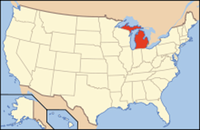
Rockhounding Michigan
Michigan is a good state for rockhounding. The state is famous for its legendary copper deposits in the Upper Peninsula (and Ben Franklin’s negotiating skills) as well as its extensive iron ore deposits. Michigan also is famous for its Petoskey stones (fossilized coral). Rockhounders also may find banded agates, jasper, chert, and other specimens.
State Rocks, Gemstones, Minerals, Fossils, & Dinosaurs
Rockhounding Tip: Knowing state rocks, gemstones, minerals, fossils, and dinosaurs often can be very useful information for rockhounders. Ordinarily, states with significant mineral deposits, valuable gemstones, fossils, or unusual or significant rock occurrences will designate an official state mineral, rock/stone, gemstone, fossil, or dinosaur to promote interest in the state’s natural resources, history, tourism, etc. Accordingly, such state symbols often are a valuable clue as to potential worthwhile rockhounding opportunities.
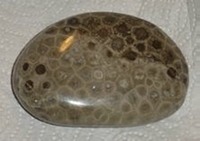
Petoskey Stone (polished)
State Rock: Petoskey Stone [Fossilized Coral] (1966)
Michigan designated the Petoskey stone
as its official state rock in 1966 and became the first state in the nation to
designate a fossil as an official symbol. The Petoskey Stone was named the state stone
four years before the coral species it is made of was scientifically
described. Petoskey Stones are common in
the northern part of the Lower Peninsula, and are actually fragments of
Devonian Period coral reefs. These reefs
grew in what is now Michigan about 360 million years ago, when a shallow sea
covered the area. The particular species
of coral represented is Hexagonaria percarinata, an example of what is known as
a tabulate coral, one of two main types (along with rugose "horn"
corals) that made up the reefs of the Paleozoic Era. Both tabulate and rugose corals were decimated
at the end of the Paleozoic, and replaced by the scleractinian corals that are
common in reef environments today.
Michigan was extensively resurfaced by
glaciers during the Pleistocene (the last 1.6 million years), and as part of
this process, moving glaciers plucked up pieces of the bedrock and carried them
along, smoothing and rounding them in transport. This accounts for the regular shapes of
Petoskey Stones found today. Good
Petoskey Stones may be collected at Fisherman's Island State Park near
Charlevoix, and at the south end of the beach at Petoskey State Park. In the late 1990s, the largest Petoskey Stone
yet discovered, an amateur fossil hunter at Sleeping Bear Dunes National
Lakeshore found a one-ton monolith. Most
of the Petoskey stones found along beaches and in gravels have already been
rounded and smoothed by glacial and water action. Many of these are suitable for hand polishing
and will often take a high polish. Occasionally a Petoskey stone will be found in
"rough" form that has not been subjected to smoothing by glacial or
wave action.

Chlorastrolite
State
Gemstone: Chlorastrolite (1973)
Michigan designated
chlorastrolite (also known as greenstone or Isle Royale Greenstone because of
its color) as its official state gemstone in 1973. Chlorastrolite actually is a variety of the
mineral known as pumpellyite. It is
found chiefly as small rounded beach pebbles along the shore of Lake Superior
and on Isle Royale. Gem varieties are
found only in Michigan.
Chlorastrolite is a beautiful green mineral with a
chatlyant "turtle-back" pattern. The name chlorastrolite comes from the words
chloros (green), aster (star), and lithos (stone). It isn’t always green. Rather, its colors range from yellow-green to
almost black.
Greenstone formed as small vesicle fillings in basalt. The usual size varies between 1/8 and 1/2 inch
(but larger stones are found). What is thought to be the largest chlorastrolite
in existence is at the Smithsonian and measures 1-1/2 by three inches.
You can
find gem-quality chlorastrolite at the mine dumps if you look carefully. Greenstones have been found at most of the
mines at Keweenaw; however, some mines produce better greenstones than other
mines. The Central Mine, located just off US 41 north of Calumet, has been the
source of some of the largest greenstones. To this day, many persons fail to realize that
much of the chlorastrolite occurred under the Keweenaw Peninsula and was
discarded on mine dumps by the copper miners when they tunneled to the copper. The mines are not operating now and new
material is not being brought to the surface, but the greenstones are usually
overlooked by the rockhounds searching for copper.

Mastodon at the University of Michigan
State
Fossil: Mastodon (2002)
Michigan designated the mastodon (Mammut
americanum) as its official state fossil in 2002.
Mastodons are found as
fossils all over the Great Lakes Region and Upper Midwest, with over 250
discoveries in Michigan alone. They were
large members of the elephant family that stood as such as ten feet high at the
shoulder. Many people are confused as to
what the difference is between a mammoth and a mastodon. In short,
mammoths were larger and had teeth adapted primarily for grazing, whereas
mastodons were browsers (leaf eaters) with multi-cusped teeth. Mastodon fossils are most often found in
regions that were forested during the Late Pliocene and Pleistocene epochs (4
million - 10,000 years ago). The only
known mastodon trackway was uncovered near Saline, Michigan and a cast of it is
on display at the University of Michigan in Ann Arbor.
Rockhounding Resources

State-specific rockhounding books (including the books listed here as well as other books), regional rockhounding site guides, and other helpful rockhounding resources are identified - by category - in the Books & Gear section of Gator Girl Rocks with a link to the Gator Girl Rocks Amazon Store where you may easily browse selected resources and securely place an order. Your order will benefit Charity Rocks!
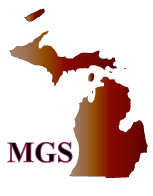
- Dan R. Lynch & Bob Lynch, Michigan Rocks & Minerals: A Field Guide to the Great Lake State (2010).
- Joseph J. Kchodl, The Complete Guide to Michigan Fossils (May 2006).
- Bruce Mueller & William Wilde, The Complete Guide to Petoskey Stones (June 2004).
- Kevin Gauthier & Bruce Mueller, Lake Huron Rock Picker's Guide (2010).
- Bruce Mueller & Kevin Gauthier, Lake Superior Rock Picker's Guide (2007).
- Bruce Mueller & Kevin Gauthier, Lake Michigan Rock Picker's Guide (2006).
- Bob Lynch & Dan Lynch, Lake Superior Rocks & Minerals:A Field Guide to the lake Superior Area (2008).
- June Culp Zeitner, Midwest Gem, Fossil, & Mineral Trails: Great Lakes States (Rev. ed., June 1999)
- June Culp Zeitner, Midwest Gem, Fossil, & Mineral Trails: Great Lakes States (Rev. ed., June 1999 – originally published 1956).
- Allan W. Eckert, Earth Treasures Vol. 1 - Northeastern Quadrant (1985; reprint in 2000).
- James Martin Monaco & Jeannette Hathway Monaco, Fee Mining & Mineral Adventures in the Eastern U.S. (2d ed. 2010).
- Kathy J. Rygle & Stephen F. Pedersen, Northeast Treasure Hunter's Gem & Mineral Guide (4th ed. 2008).
Museums of Interest to Rockhounders

A.E. Seaman Mineral Museum – The Mineral Museum of
Michigan
Houghton, Michigan
The museum is the official mineral museum of the state of Michigan. The museum offers the visitor the opportunity to see the worlds’ finest collections of Keweenaw Copper District minerals, Lake Superior Iron District minerals, Michigan minerals, and one of the best fluorescent mineral exhibits in the United States. It also offers one of the largest systematic mineral collections on public view in North America.
University of Michigan Museum of Natural History
Ann Arbor, Michigan
Permanent Exhibits include the most extensive prehistoric life collection in the State of Michigan and rock and mineral specimens in the Geology section.

Cranbrook Institute of Science
Bloomfield Hills, Michigan
The Institute’s Mineral Study Gallery has over 11,000 specimens and the museum exhibits rocks, minerals, and fossils.
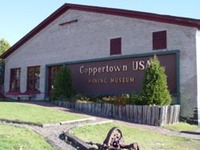
Coppertwon USA Mining Museum
Calumet, Michigan
Museum focuses on Michigan’s famed historic copper mining industry.
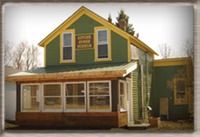
Gitche Gumee Agate & History Museum
Grand Marias, Michigan
This small museum exhibits rocks, minerals, gems, and fossils but focuses mainly on Lake Superior Agates.
Places to Visit - Interesting Sites To See

Isle Royale National Park
Houghton, Michigan
Located on Isle Royale, the largest island in Lake Superior, and nearby islands, the Park includes an ancient Indian copper mining site. The copper on the island occurs in pure form.
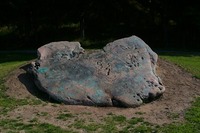
Largest Glacial Float Copper
Presque Isle Park
Marquette, Michigan
In addition to seeing the 10,000-year-old bog,
visitors may see the world’s largest piece of glacial float copper, which is
displayed at the park. The specimen,
weighing more than forty tons, is approximately fifteen feet in diameter. Float copper is formed naturally and is
‘floated’ along by glaciers. This
specimen was discovered in 1997 near Hancock.

Gerald E. Eddy Discovery Center
Waterloo Recreation Area – Chelsea, Michigan
The discovery center includes geologic exhibits
as well as an outdoor trail with informative specimens.
Rockhounding Sites for Children & Families
Petoskey Stone
Petoskey, Michigan
Petoskey stones are found almost
exclusively on the beaches from Grand Traverse Bay to Little Traverse Bay and
gravel deposits up to 30 miles inland on Michigan’s lower peninsula. They are particularly abundant in the tourist
region of the same name, the area around the town of Petoskey.
Copper
Delaware Copper Mine – South of Copper Harbor, Michigan
Commercial (fee access) business. In addition to a tour of a copper mine,
visitors may collect copper specimens.
Crystallized Copper
Keweenaw Peninsula, Michigan
Michigan’s Keweenaw Peninsula is famous for its
crystalized copper specimens.

Fossils – Devonian
Lafarge Fossil Park, Alpena, Michigan
The Lafarge Fossil Park –
located at the Besser Museum for Northeast Michigan in Alpena, Michigan – contains
Devonian age fossil material (limestone) donated by Lafarge. You are allowed to collect fossils.
